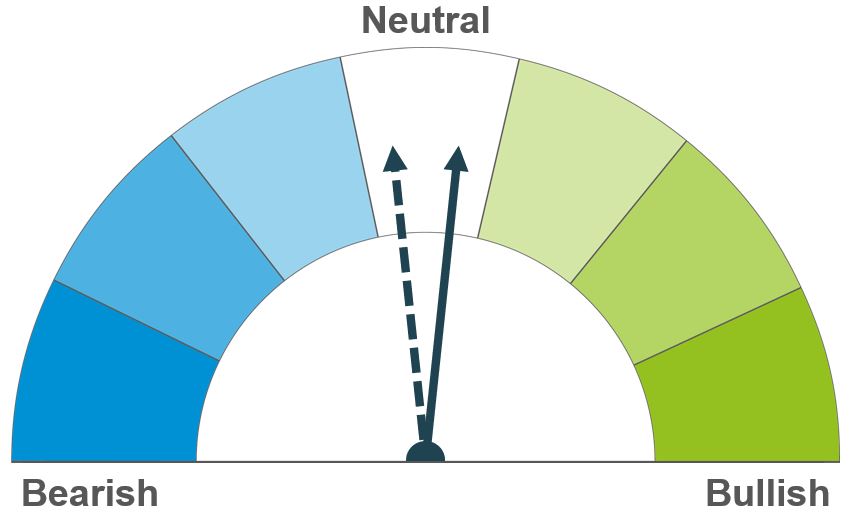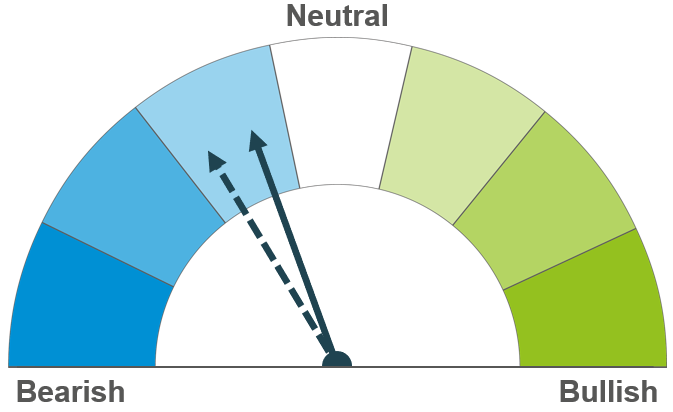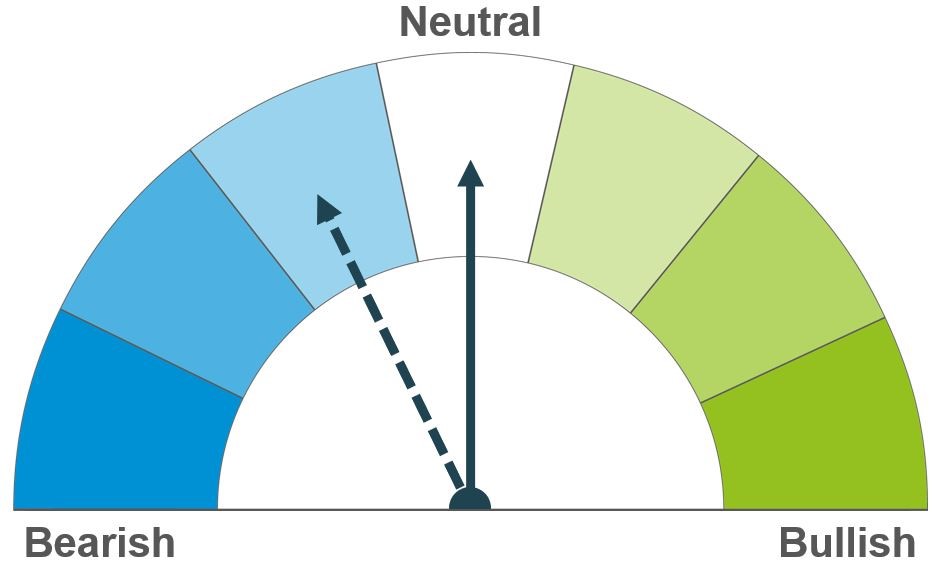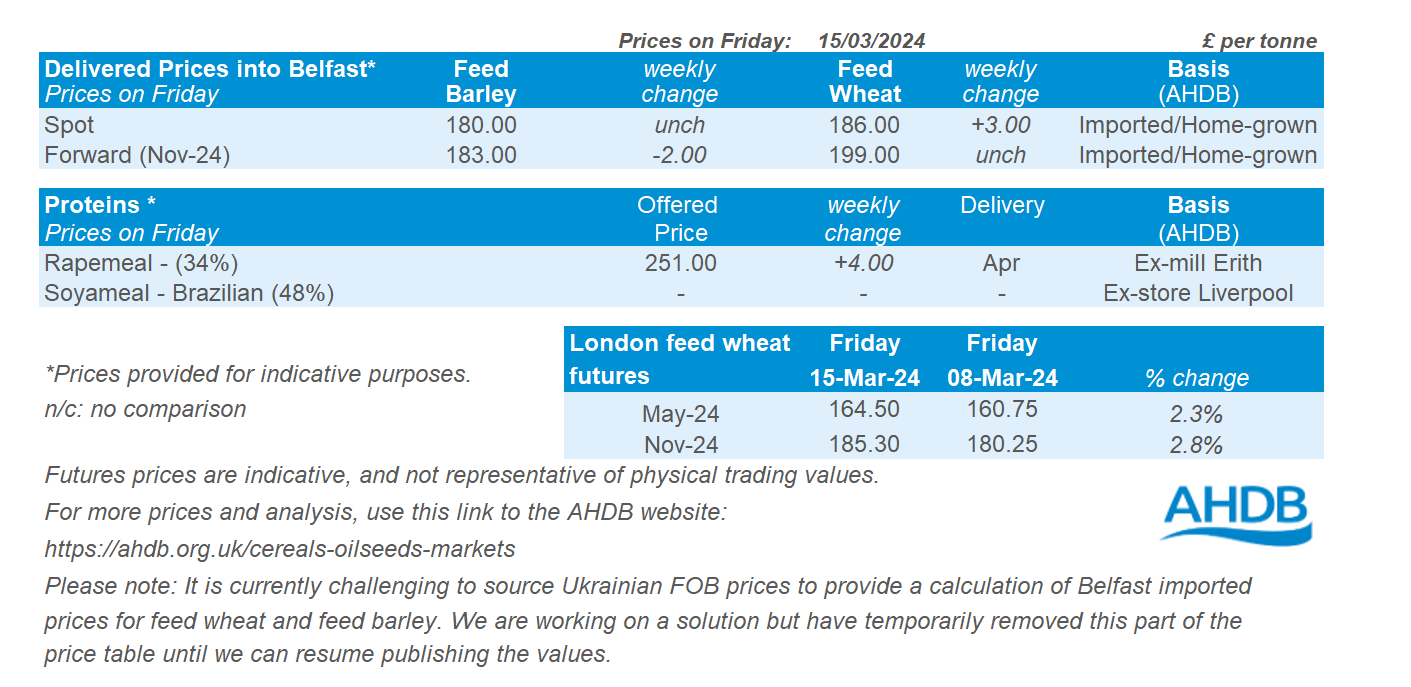Arable Market Report - 18 March 2024
Monday, 18 March 2024
This week's view of grain and oilseed markets, including a summary of both UK and global activity.
Grains

Wheat
Maize
Barley

While large Russian supplies hang over the market, there’s uncertainty about the outlook for the global wheat market in 2024/25. Weather is likely to be a key influence in the coming weeks.

Current forecasts continue to show large global maize supplies this season – dependent on a large Brazilian Safrinha crop, which will be harvested from June through to September. US maize areas will be important to the outlook for 2024/25 – planting intentions data is out next Thursday (28 March).

Farmers intending to plant less acres in Canada, and planting delays in parts of Europe mean uncertainty for the longer-term outlook.
Global grain markets
Global grain futures
It was a mixed week for global grain prices, with week-on-week falls in the US markets but rises for Paris wheat and maize futures.
Grain futures markets rose in the early part of last week due to technical trading and speculative traders covering short positions. Expectations of a smaller Ukrainian harvest in 2024 and ongoing rain in Europe’s top exporter, France, were also factors. The Ukrainian Grain Association forecasts an 18% drop in Ukraine grains and oilseeds exports in 2024/25 to 43.7 Mt. Conab also trimmed 0.9 Mt from its 2023/24 Brazilian maize crop forecast, though the key growing periods are still to come.
However, later in the week the markets eased back, with competition for exports still a factor. LSEG reported that Chinese importer cancelled or postponed imports of about 1.0 Mt of wheat from Australia, due to recent price falls. On Thursday, data also confirmed the cancellation of 504 Kt of wheat imports by China from the US. A stronger US dollar exacerbated the falls in the US futures markets, while a weaker euro helped reduce the losses for the Paris futures.
The International Grains Council (IGC) forecasts global grain production will rise 28 Mt year-on-year to 2,332 Mt in 2024/25. This is driven by larger Brazilian and Chinese maize crops, plus recoveries in wheat production in Australia and Argentina; but tempered by lower US maize and EU wheat production. However, due to rising global demand the IGC predicts total grain supply and demand will be finely balanced in 2024/25, with another year-on-year fall in global wheat stocks.
Stratégie Grains reduced its forecasts for EU-27 wheat and barley production in 2024 last week due to wet weather, particularly France. Maize output could rise as a result. The wheat crop (exc. Durum) is now seen at 121.6 Mt, down 1.0 Mt from February and 4% below 2023. Total barley is now seen at 51.8 Mt, 1.3 Mt lower than in February but still 4% higher than 2023.
French soft wheat crop rating slipped two percentage points last week with 66% of the crop now rated good/very good. This is the lowest rating since 2020 when it sat at 63%. Continued rainfall has impacted the crop, though there are hopes for a dry spell over the next few weeks.

UK focus
Delivered cereals
Old crop UK feed wheat futures saw some support last week from the Paris futures market and sterling weakening against the US dollar. The May-24 contract closed at £164.50/t on Friday, up £3.75/t over the week. However, New crop (Nov-24) futures were up over the same period by £5.05/t, closing at £185.30/t.
UK delivered prices generally followed futures movements Thursday to Thursday. Feed wheat delivered into East Anglia for March delivery was quoted at £162.00/t on Thursday, up £4.00/t over the week. Bread wheat delivered into the Northamptonshire for March delivery was quoted at £241.00/t on Thursday, up £2.50/t on the week.
After an extremely challenging autumn, AHDB has released the results of the re-run of the Early Bird Survey to capture the potential cropped areas for harvest 2024. The wet autumn was followed by severe weather throughout the winter impacting crops and resulting in winter losses. The survey results have revealed a large reduction in winter crop areas and more spring crops, including the following changes year-on-year:
- Wheat down 15% to 1.463 Mha
- Oilseed rape down 28% to 280 Kha
- Winter barley down 22% to 355 Kha
- Spring barley up 29% to 881 Kha
- Oats up 26% to 209 Kha.
There is still a window for planting spring crops, but if the rain persists and this window narrows crops could become economically unviable.

Oilseeds
Rapeseed
Soyabeans

In the short-term, rapeseed prices are supported from anticipated reductions to the Canadian area for harvest 2024. But, longer-term, rapeseed markets will largely follow the sentiment of soyabeans.

The on-going South American soyabean harvests could continue to weigh on the market, with substantial crops still expected. US plantings and Chinese demand are key for market direction longer-term.
Global oilseed markets
Global oilseed futures
It was yet another week of support for Chicago soyabean futures (May-24); the market closed Friday at $440.24/t, gaining 1.2% across the week. Supporting the market was strong domestic demand in the US, short-covering by speculative traders and technical trading. This comes as speculators are still heavily betting on lower soyabean prices. The fundamentals in the oilseed markets still show a bearish outlook as a record South American soyabean production comes to market. Further to that, there are questions over Chinese demand, which is expected substantial going forward.
Brazil’s soyabean harvest is still on-going, it was reported last Friday that the harvest is 62.3% complete. Despite the rapid start this year, progress is now marginally behind the same point last year of 62.9% (Patria Agronegocios). Conab lowered its production forecasts of Brazil’s soyabean crop by 2.6 Mt last week, with the crop now estimated at 146.9 Mt and a lot lower than the USDA’s estimate of 155 Mt. This crop is still substantial, plus recent rains in Argentina have boosted production outlooks. The Rosario Grain Exchange upped its production estimate by 0.5 Mt last week, with the soyabean crop now estimated at 50.0 Mt.
US domestic demand remains strong as the National Oilseed Processors Association (NOPA) estimated that the US February 2024 soyabean crush was 5.1 Mt, up 0.2% from January’s figure, and up 12.6% from February 2023. This is the highest February crush ever recorded.
The USDA reported net export sales of US soyabeans (week ending 7 March) at 376 Kt for the 2023/24 marketing year, towards the low end of trade expectations of 250 Kt to 800 Kt. Demand for US soyabeans usually starts to dwindle due to seasonality at this time of year, as Brazil’s crop comes to the market.
Key watchpoints for old crop oilseeds are that excessive rains in Argentina need to stop as the soyabean harvest begins. If excessive rains continue, they could provide a bit of short-term support to markets in a couple of weeks’ time.

Rapeseed focus
UK delivered oilseed prices
Rapeseed prices were supported last week by support in Chicago soyabeans, Malaysian palm oil and crude oil. From this, Paris rapeseed futures (May-24) closed up across the week by €13.00/t, closing at €436.25/t on Friday. New crop (Nov-24) futures were up €15.00/t over the same period, closing at €443.25/t.
Domestic delivered prices gained with the futures market as delivered rapeseed (into Erith, Hvst-24) was quoted at £369.50/t on Friday, up £9.00/t across the week.
Statistics Canada estimated last Monday that farmers will plant 8.7 Mha of canola for harvest 2024, down 3% from last year. This is possibly in response to the general downturn in rapeseed/canola prices, all focus will be on planting on the Canadian Prairies in the coming weeks.


While AHDB seeks to ensure that the information contained on this webpage is accurate at the time of publication, no warranty is given in respect of the information and data provided. You are responsible for how you use the information. To the maximum extent permitted by law, AHDB accepts no liability for loss, damage or injury howsoever caused or suffered (including that caused by negligence) directly or indirectly in relation to the information or data provided in this publication.
All intellectual property rights in the information and data on this webpage belong to or are licensed by AHDB. You are authorised to use such information for your internal business purposes only and you must not provide this information to any other third parties, including further publication of the information, or for commercial gain in any way whatsoever without the prior written permission of AHDB for each third party disclosure, publication or commercial arrangement. For more information, please see our Terms of Use and Privacy Notice or contact the Director of Corporate Affairs at info@ahdb.org.uk © Agriculture and Horticulture Development Board. All rights reserved.

